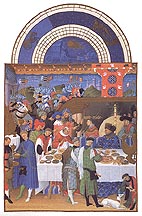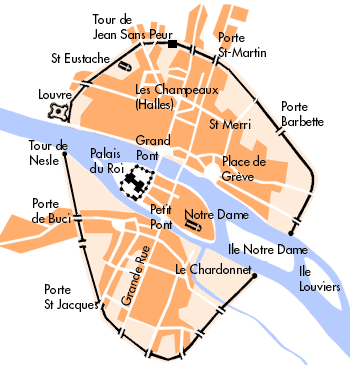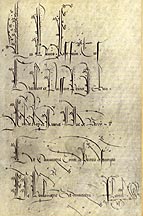
Art Home | ARTH Courses | ARTH 200 Assignments
Gender and Social Construction in the
Très riches heures
The Calendar miniatures
from the Très riches heures present us with a remarkable document
pertaining to gender and social construction in Europe at the beginning of the
fifteenth century. This manuscript is one of the most famous monuments of court
patronage. The manuscript is a Book of Hours, a type of prayer book intended
for the private use of a member of the laity. Like many Books of Hours, the
Très riches heures was made especially for its original owner:
John of Berry,
the son of King John the Good of France, the brother of King Charles V, and
the uncle of King Charles VI. He was thus one of the most powerful and wealthy
men in France. His status is reflected in the luxury objects like the Très
riches heures that he acquired. We should pay attention to the contradictory
motivations in acquiring this manuscript: object of Christian piety and use
as a symbol of status. As we will see when we examine the manuscript in detail,
it is hard to miss the sense of pride.
The Très riches heures' fame is due to the extraordinary series
of miniatures decorating the manuscript. These pictures were the work of the
so-called Limbourg
brothers. Traditional
scholarship has emphasized the extraordinary "naturalism" of the
paintings. The sense of illusionistic space and attention to light are unprecedented
at this period.
The attention to detail derived from observation of the world is evident in the snowscape of the February page or the cast shadows found in the miniature accompanying October. The representation of the Louvre in the background of the October page has been a crucial document in the reconstruction of the early form of this important building. Identify details included in the February page that are drawn from the experience of winter in northern Europe. Just about every miniature includes details derived from empirical obervation of the world. This "naturalism" lends a veracity to these miniatures. The paintings tempt us to view them as neutral or transparent records of the fifteenth century. As the most recent scholarly study of the manuscript has emphasized, the "scenes are constructs, and must not be seen, for all their 'realism,' as neutral" (Alexander 438). These miniatures make us aware of we might call the "reality effect." As European art becomes increasingly concerned with representing the world of visual experience, we must be careful to avoid the assumption that the images are more truthful and present transparent records of the world. Instead of seeing how the artists "reflect" or "mirror" the world, we should explore how the artists construct visions of the world based on their (and/or their patrons) particular ideological conceptions. It is thus more appropriate to understand the miniatures in the Très riches heures as constructs made intentionally by the Limbourg brothers to present the ideology of John of Berry. We will find that the miniatures present the world as seen from the social and political point of view of Jean de Berry.
We will particularly focus on the calendar sequence. The following annotations are intended to spark your thinking about the miniatures.
![]() January : John of Berry
is shown seated on the right in front of the gold firescreen. To his right stands
an usher above whom appears the words "Aproche, aproche" (Approach,
approach). Consider the significance of this figure and the words he says in
the context of our discussion of court culture. This scene represents the New
Year's day feast. The feast takes place in one of the grand halls of one of
Jean de Berry's palaces. The hall from Berry's palace at Poitier (possibly represented
in the July page) is
still extant and gives us a sense of the size of this type of space:
January : John of Berry
is shown seated on the right in front of the gold firescreen. To his right stands
an usher above whom appears the words "Aproche, aproche" (Approach,
approach). Consider the significance of this figure and the words he says in
the context of our discussion of court culture. This scene represents the New
Year's day feast. The feast takes place in one of the grand halls of one of
Jean de Berry's palaces. The hall from Berry's palace at Poitier (possibly represented
in the July page) is
still extant and gives us a sense of the size of this type of space:
The Duke's table was placed on a dias reached by stairs at the end of the long hall. An imposing three-part fireplace with elaborate sculptural decoration would have been behind the Duke's table much like in the Très riches heures miniature.
Consider from your own experience
what is the significance of a feast. Identify different feasts that are a part
of your experience. We will have to come to an understanding of what is the
significance of this feast in this culture.
Consider who is included and who is excluded from this feast and why? Scholars
have identified the tapestry decorating the back wall as a representation of
the Battle of Troy. Why do you think this is included in the painting?
"Estrennes" or the New Year's Day feast was the principal day for gift giving [for more on the importance of gift giving in court culture see the excerpts from Brigitte Buettner's recent article]. The exchange of gifts was sign of the mutual obligation between the lord and his vassals. The sideboard on the left hand side of the miniature is full of goldsmith work which are presumably gifts. New Years' gifts played an important role in the development of the manuscript collections of royal and ducal households. As an example of this, the following entry comes from the accounts of Philip the Bold the Duke of Burgundy. It records the gift by Jacques Rapondi, an Italian merchant active in Paris, of a copy of the new translation of Boccaccio's Concerning Famous Women:
"A Jaques Raponde, marchant bourgois de Paris, auquel mon dit seigneur de grace especial a donné la somme de IIIc frans tant pour et en recompensacion d'un livre en françois de pluseurs histoires de femmes de bonne renommee qu'il lui donna aux estraines du jour de l'an derrenierement passé, comme pour les bons services qu'il lui faiz chascun jour et espere que face ou temps avenir, si comme il appert plus a plain par les letres patentes dudit seigneur sur ce faictes, donnees a Paris le XXIe jour de janvier l'an mil CCCC et deux cy rendu avec quictance. Pour ce IIIc frans." (Dijon, ADCO B1532 f 156r-156v; as quoted in Pierre Cockshaw, "Mentions d'auteurs, de copistes, d'enlumineurs et de libraires dans les comptes généraux de l'état Bourguignon," Scriptorium 23 (1969), 135, no. 49).
The wording of this account is worth noting. The 300 francs Philip gave to Rapondi in return was not considered a payment for the book, but the money is seen as a gift in return "for the good services that Rapondi has done for the Duke each day and the hope for this to continue in the future." The exchange is thus a sign of the past and future loyalty between the Duke and Rapondi.
Like the other calendar pages, astrological and calendrical information along with the symbols of the zodiac appear in the arch above the miniature. Consider the relationship between this and the miniatures beneath.
I have developed a page dedicated to Court Culture for my Northern Renaissance art class.
Implicit in this miniature are the codes of space evident in this culture. In a Palace the space was very controlled, and your importance was directly connected to the spaces you had access to. The miniature below comes from another French manuscript from slightly earlier than the the Trés riches heures:
The miniature documents the privilege of the author, Pierre Salmon, had of presenting the manuscript to King Charles VI in the presence of the highest aristocrats in France including the Duke of Berry. The artist clearly shows the controlled spaces of the palace.
To have the highest privilege at this period would be to have access to the bedchamber of the King. Presentation images from this period will be set in the bedchamber. Another Pierre Salmon manuscript shows the offer receiving instructions from Charles VI:
It is important to note that this is the King's bedchamber. The Queen had a separate chamber. The presentation image from the collected works of Christine de Pizan shows Christine presenting her collected works to Isabeau de Baviere, the Queen of France:
If you want to explore this topic see the pages I have developed for the Northern Renaissance Art class entitled:Christine de Pizan and Establishing Female Literary Authority
![]() February:
Art historians frequently point to the details of this miniature as clear manifestations
of the increasing "naturalism" of the art of the period, but I would
like to see this miniature as being intentionally compared to the preceding
one. Compare them and try to define ideological assumptions implicit in the
comparison.
February:
Art historians frequently point to the details of this miniature as clear manifestations
of the increasing "naturalism" of the art of the period, but I would
like to see this miniature as being intentionally compared to the preceding
one. Compare them and try to define ideological assumptions implicit in the
comparison.
![]() March: In the background
of this miniature can be seen one of John of Berry's castles, Lusignan in Poitou.
We need to explain why the Limbourgs devoted such attention to the representation
of buildings associated with John of Berry. Consider the relationship between
the castle and the peasants shown in the foreground of the work. How are work
or labor conceived of in this culture as opposed to our modern ideas? The following
quotation from A.J Gurevich's book Categories of Medieval Culture provide
us a useful critical perspective to evaluate this culture's conception of labor
and property:
March: In the background
of this miniature can be seen one of John of Berry's castles, Lusignan in Poitou.
We need to explain why the Limbourgs devoted such attention to the representation
of buildings associated with John of Berry. Consider the relationship between
the castle and the peasants shown in the foreground of the work. How are work
or labor conceived of in this culture as opposed to our modern ideas? The following
quotation from A.J Gurevich's book Categories of Medieval Culture provide
us a useful critical perspective to evaluate this culture's conception of labor
and property:
| The world-view of any society will include that society's concepts of property, wealth, and labour. These are not only politico-economic categories but also moral and ideological ones; labour and wealth may be highly valued or despised, their role in human affairs can be variously assessed. Economic activity is a component of social practice, of the interaction between man and his environment. It reflects the vital preoccupations of a society, and if we are to penetrate the mental climate of this society it is particularly important for us to try to understand its attitudes to labour and property. |
![]() April: This miniature
has been identified as an espousal or engagement scene. What would be the significance
of a scene like this for John of Berry? Consider why the detail of the enclosed
garden has been included on the right hand side of the miniature. As part of
our discussion we will need to examine this culture's conception of marriage
as an institution. What are your expectations about the nature of marriage?
April: This miniature
has been identified as an espousal or engagement scene. What would be the significance
of a scene like this for John of Berry? Consider why the detail of the enclosed
garden has been included on the right hand side of the miniature. As part of
our discussion we will need to examine this culture's conception of marriage
as an institution. What are your expectations about the nature of marriage?
![]() May: Represents May Day with a
calvacade of nobility out for a ride in the countryside. The buildings in the
background represent Paris. We need to consider the social implications of May
Day for the aristocracy. I would like it if anyone who has taken a literature
course that has considered the Romance as a medieval literary form would be
willing to present their understanding of the nature of Romantic love.
May: Represents May Day with a
calvacade of nobility out for a ride in the countryside. The buildings in the
background represent Paris. We need to consider the social implications of May
Day for the aristocracy. I would like it if anyone who has taken a literature
course that has considered the Romance as a medieval literary form would be
willing to present their understanding of the nature of Romantic love.
![]() June: In the background
of this haymaking scene can be seen the Ile de la Cité in Paris. This
island in the Seine is the heart of Paris. Identifiable are the buildings that
form part of the old French royal palace including Sainte Chapelle on the right,
the private chapel of the French monarchy. It has been observed that the point
of view presented in the miniature corresponds to that from the Hôtel
de Nesle, John of Berry's Paris residence.
June: In the background
of this haymaking scene can be seen the Ile de la Cité in Paris. This
island in the Seine is the heart of Paris. Identifiable are the buildings that
form part of the old French royal palace including Sainte Chapelle on the right,
the private chapel of the French monarchy. It has been observed that the point
of view presented in the miniature corresponds to that from the Hôtel
de Nesle, John of Berry's Paris residence.
![]() October: In the background
of this miniature appears the Louvre, the new royal palace. Like the June miniature,
the point of view presented in the miniature corresponds to that from the Hôtel
de Nesle. You might consider the significance of incorporating this perspective
in both of these miniatures. Especially consider the ideological and political
implications.
October: In the background
of this miniature appears the Louvre, the new royal palace. Like the June miniature,
the point of view presented in the miniature corresponds to that from the Hôtel
de Nesle. You might consider the significance of incorporating this perspective
in both of these miniatures. Especially consider the ideological and political
implications.
Compare the June and October pages to this map of late medieval Paris:

![]() Zodiac Man: At the end of
the calendar appears this curious illustration. It shows a man in conjunction
with the zodiacal symbols. It demonstrates one of the basic tenets of astrology:
how "Man" (sic) the microcosm is controlled by the heavens, the macrocosm.
Zodiac Man: At the end of
the calendar appears this curious illustration. It shows a man in conjunction
with the zodiacal symbols. It demonstrates one of the basic tenets of astrology:
how "Man" (sic) the microcosm is controlled by the heavens, the macrocosm.
![]()
 The miniature of the Annunciation is paired
on the facing page with an illustration of the Fall of Man including the Temptation
and Expulsion from the Garden of Eden. Why would this miniature be paired with
the Annunciation?
The miniature of the Annunciation is paired
on the facing page with an illustration of the Fall of Man including the Temptation
and Expulsion from the Garden of Eden. Why would this miniature be paired with
the Annunciation?

Many of the books owned by John of Berry open with an ex libris like the one above. Written and signed by the Duke's secretary Jean Flamel, these inscriptions assertively attest to the Duke's ownership of the particular book. This one comes from the Belles heures, the earlier Book of Hours the Limbourg brothers made for Jean de Berry about 1409. The text reads: "Ces heures fist faire tres excellent et puissant Prince Jehan --filz du Roy de France-- Duc de Berry et Dauvergne Conte de Poitou destampes de Bouloingne et dauvergne. Flamel [This Book of Hours was made at the command of the most excellent and powerful Prince John -- the son of the King of France (John)-- Duke of Berry and of Auvergne, Count of Poitou, of Estampes, of Boulogne, and of Auvergne. Flamel]" Aside from identifying the ownership of the particular book, these ex libris identify John of Berry. Compare this identification of John of Berry to the calendar pages of the Très riches heures.
|
|
|
|
|
|
|
|
|
|
|
|
|
|
|
|
Web Resources:
There are two excellent websites that focus on the Très riches heures.
There are also good quality reproductions of the Calendar miniatures available
over the World Wide Web from the University
of Chicago. There is a useful commentary for each of the calendar miniatures.
The Vatican site Christus
rex has a page that is virtually a complete facsimile of the Très
riches heures. Spend time examining the manuscript through these two
sites.